Sunday 5 December 2010
LCF Fashion show
Here are a few images of a fashion show by LCF held at the V&A. It was a culmination in a two year project with the BA Fashion students and the museum drawing on influences from the Ballets Russes. The highlight of the evening was an incredible live ballet performance by the English National ballet accompanied by an orchestra. The dancers wore some students' costumes.
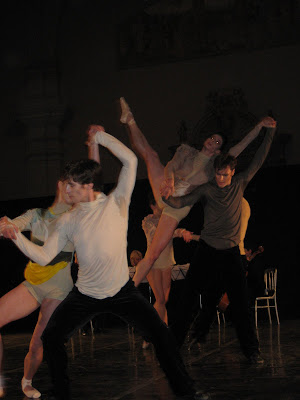
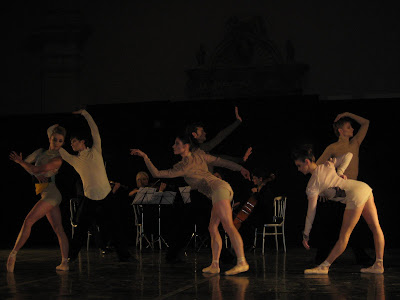





Trade between East and West- V&A
'God is as everlasting as the dyed textiles of India'
A recent Friday theory excursion to the South Asian and British galleries with historian Clare Rose was a thoroughly interesting experience and gave me incredible insight into the strong influence of the east. It appears Indian textiles have been around since the year dot.In the year 700 in a written Bible the question 'How wise is God?' was posed. The Catholic church replied with a metaphor translated as 'God is as everlasting as the dyed textiles of India'. Incredible! The V&A displays a selection of medieval Indian textiles found in an Egyptian rubbish tip around 1300, and still in a beautiful yet extremely fragile condition. Indian textiles were of high quality and remarkable skill.
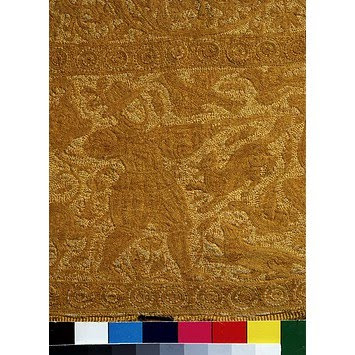
This stunning yellow coverlet embroidered with silk thread from special silk worms only found in Bengal displays the coat of arms of a Portuguese family. Indian bedcovers were seen as a prized possession in Europe and therefore many Indian hand crafted goods were destined for the western market.
This handspun muslin gown, once again embroidered in Bengal has the unmistakable design of a British 'Jane Austen' style couture dress. Once again, designed in Europe, made in India.
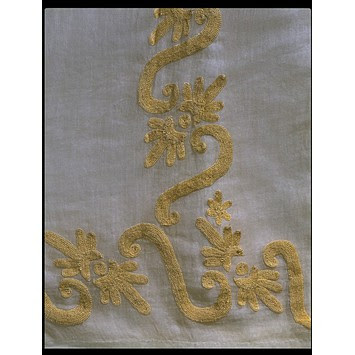
As well as textiles, other Indian goods such as jewelry were imported in the 1850s to show and inform British students on 'good design'.

One thing I found particularly fascinating was the emergence of 'Bizzare Style' in high fashion during the period 1700-1720. It is basically a Chintz hand painted in India with a mishmash of design references, e.g. peonies and pegodas' from China alongside Turkish tulips.
Another interesting concept which arose took me back to our initial Rough Guide project. We had to write about three objects- one found or second hand, one from a shop and one from a museum and discuss how placing them in a different context altered our perceptions of them. In the British galleries, many items convey this concept. For example a cheap Chinese ceramic bowl, probably considered to be a common and worthless everyday item in China has been perceived by the west as an item of extreme beauty and value and thus gold handles and a gold lit has been added to the bowl. Take an item out of its everyday surroundings and it gains a whole new identity. One of the strangest examples of this is the gold mounted coconut cup-
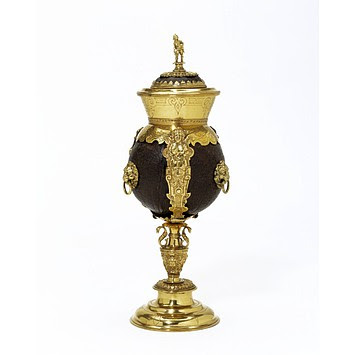
As such a rarity in the West, the coconut must have been seen as extremely exotic and desirable. I for one will never look at a coconut in the same way!
A recent Friday theory excursion to the South Asian and British galleries with historian Clare Rose was a thoroughly interesting experience and gave me incredible insight into the strong influence of the east. It appears Indian textiles have been around since the year dot.In the year 700 in a written Bible the question 'How wise is God?' was posed. The Catholic church replied with a metaphor translated as 'God is as everlasting as the dyed textiles of India'. Incredible! The V&A displays a selection of medieval Indian textiles found in an Egyptian rubbish tip around 1300, and still in a beautiful yet extremely fragile condition. Indian textiles were of high quality and remarkable skill.
This stunning yellow coverlet embroidered with silk thread from special silk worms only found in Bengal displays the coat of arms of a Portuguese family. Indian bedcovers were seen as a prized possession in Europe and therefore many Indian hand crafted goods were destined for the western market.
This handspun muslin gown, once again embroidered in Bengal has the unmistakable design of a British 'Jane Austen' style couture dress. Once again, designed in Europe, made in India.
As well as textiles, other Indian goods such as jewelry were imported in the 1850s to show and inform British students on 'good design'.
One thing I found particularly fascinating was the emergence of 'Bizzare Style' in high fashion during the period 1700-1720. It is basically a Chintz hand painted in India with a mishmash of design references, e.g. peonies and pegodas' from China alongside Turkish tulips.
Another interesting concept which arose took me back to our initial Rough Guide project. We had to write about three objects- one found or second hand, one from a shop and one from a museum and discuss how placing them in a different context altered our perceptions of them. In the British galleries, many items convey this concept. For example a cheap Chinese ceramic bowl, probably considered to be a common and worthless everyday item in China has been perceived by the west as an item of extreme beauty and value and thus gold handles and a gold lit has been added to the bowl. Take an item out of its everyday surroundings and it gains a whole new identity. One of the strangest examples of this is the gold mounted coconut cup-
As such a rarity in the West, the coconut must have been seen as extremely exotic and desirable. I for one will never look at a coconut in the same way!
Saturday 4 December 2010
Design Museum Fashion talks
Hywel Davies interviewing the flamboyantly dressed Fred Butler.
The 'Sparkle the Dark up' event at the Design Musuem although not particularly sparkly, was nonetheless pretty interesting. Hywel Davies, author of 'Fashion Designers' Sketchbooks' gave 4 key contemporary fashion figures a real grilling- Richard Nicoll, Fred Butler, Bora Asku and Amy Moleyaux from PPQ. A key point raised by each of the designers and which seems to be a reoccuring theme in every talk/ exhibition I visit is the importance of collaboration. Fashion designers are increasingly looking to join forces with artists, filmakers, musicians, choreographers etc. Fred Butler, a remarkably subdued character in contrast with her crazy otherworldly accessories talked about her love of learning old crafts from second hand books and then applying them to synthetic materials. She described her USP (Unique selling product) by the fact that her creations perplex people and they aren't able to figure out how she has made them. Bora Asku gave a plug to carboot sales in Vauxhall and Portabello as highly inspirational places to visit. Finally, Amy Moleyeux defined the key features of the PPQ brand with the words 'dresses, surface decoration and print'. Looking at the S/S11 Collection and this is easy to see-
Designs are feminine, bold, modern and fresh.
The exhibition at the Museum - 'Drawing Fashion' was a beautiful, highly elegant collection of remarkable fashion illustrations from the twentieth and twenty first centuries. I particularly liked some of the alternative approaches to drawing and am keen to discover more about 'monotyping', a process which unlike monoprinting, removes ink to create an image. See below.
Francois Berthoud, Comme des Garcons
Vogue, Japan 2001
Linocut, monotype and collage.
Friday 26 November 2010
Diaghilev at the V&A

YSL Ballets Russes Collections
Just finished yet another highly interesting day of lectures and a museum visit led by the amazing Clare Rose. This week's topic was exoticism in design around 1900 with a particular focus on Orientalism. Asia was perceived by Europeans as an intriguing, fantastical world and increasingly, Asian motifs and influences filtered into all areas of European design, from a Chinese style pagoda in Kew Gardens to the inclusion of a Japanese print in Van Gogh's 1889 self-portrait. She raised an interesting point that middle eastern women's dress with loose flowing fabric such as harem trousers and their covered faces were a total contrast to the corseted 'protected' female bodies of the west. Europeans believed this choice of loose dress immediately eluded to sexual connotations. The influence of Diaghilev's Ballets Russes from 1909 through to its economic collapse in 1929 was phenomenal. It unarguably revolutionized early 20th century arts and continues to influence cultural activity today. It is easy to see why this particular ballet company had such an astounding effect. The bold, bright costumes, Asian influenced dance movements unusual musical accompaniment defied everyone's common expectation of a ballet. The richly embellished costumes and incredibly elaborate set design are of real beauty and provide a wealth of inspiration. In the final room the male dance costumes of Giorgio de Chirico, which are highly influenced by architecture put further emphasis on the strong connection between fashion and architecture as discussed at last night's talk at the Barbican. His bold graphic use of line reminded me of Holly Fulton's print designs.
Designer Giorgio de Chirico's ballet costumes

Holly Fulton's Spring/Summer 11 Collection
Tuesday 16 November 2010
Print design inspiration.
During our print class today I took a look at Kenny's print design books and noted a few artists work that interested me. I particularly liked the work of Tal Rosner as he unusually transforms dreary, urban buildings and objects into mesmerizing patterns. It taught me that shape and line are all around us. His video, 'Doppelganger' on his personal website is well worth a look. Funnily enough, on my walk this afternoon to my friend's house in Battersea I was struck by the stunning block shape of Battersea Power Station reflected in the Thames. I am definitely inspired to create a digital design using the buildings of London now!

Monday 15 November 2010
Ideas for print

A few weeks ago I took the opportunity to pop to the Textile and Fashion Design Museum in Bermondsey to have a look at the Horrockses Fashion exhibition. My main reason for visiting was to hopefully get inspired for my forthcoming ‘Print’ technical block as I’d heard that the fashion company, from the 40s and 50s was well know for its’ popular eye popping feminine prints. As anticipated, there were plenty of chintzy floral examples but what I liked best were the prints generated from the work of contemporary artists, such as Graham Sutherland, Eduardo Paolozzi and Louis le Brocquy. I was particularly fond of the stylized, abstract patterns of designer and textile artist Alistair Morton. During our drawing week at uni, I had been struggling to understand the type of drawings needed for print. My simple line drawings of keys were really bland and uninspirational. The abstract motifs and stylized patterns are more appropriate for the creation of a fabric used for fashion and interiors. Another designer whose simple prints caught my eye was Pat Albeck. Back at home I found more examples of her work on her website. Admittedly, her current floral, chintzy work is not really to my taste, but the work she created during the 50s and 60s is very contrasting. Abstract and expressive, her designs feature bold art-deco prints which I am certain would be appropriate for present day fashion and interiors.
Some examples of Pat Albeck's designs.
Scrappies.
During my stay at home this weekend, my mum and I decided to visit a nearby town called Church Stretton. A few people had really recommended I visit a junk shop there, which was apparently ‘right up my street’. After a challenging mission trying to track down the place, we eventually located Scrappies. It was an incredible place! As I’m currently on the look-out for ideas of collections for my Pop-Up 2 project I couldn’t quite believe that I had stepped into an 'aladins warehouse' full of collected random items. Barrels of coloured lids, zips, corks, watch straps, fabric scraps, plant pots, nurse’s uniforms, empty frames, pen lids etc etc. You name it, they had it. It’s so interesting how an object which can appear rather boring on its own can look absolutely mind-boggling when presented in hundreds. I couldn’t resist taking pictures of some of the ‘junk’, which as well as being seriously inspiring, is also ridiculously cheap! I will definitely be revisiting this place.

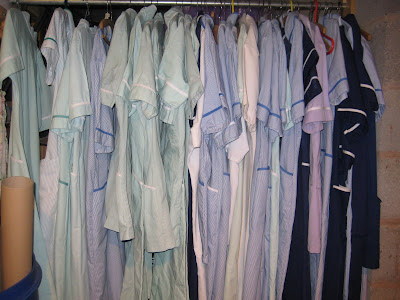
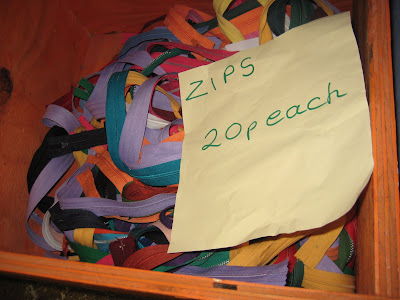
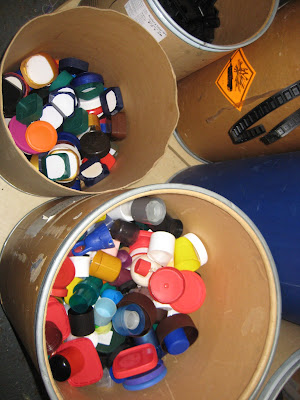

Saturday 13 November 2010
Congratulations Mary Katrantzou!

Rosamund Pike last month in a Katrantzou print from Autumn/Winter 2010.
Another contemporary fashion designer who I find particularly inspiring is Mary Katrantzou and I was so pleased to read yesterday that she won the prestigious Swiss Textiles Award 2010. My friend Lauren first introduced me to Katrantzou, the 'Princess of Prints' as she completed a placement at the studio. Her S/S 11 collection is so quirky and original with surreal prints, embellishment, fringing etc etc capturing images of lush and extravagant living spaces.


Excited for print.
I have come across the work of Holly Fulton once before but cannot for the life of me remember where! I bumped into to my friend Dominic, a fashion student at Kingston who has recently completed an internship with her and who told me to take a look at her most recent work. Her bold, geometric prints seem to play an equally important role as the design of her garments and stand out as being extremely edgy and contemporary. It really demonstrates the power of a print and has made me even more excited to start my technical block in print this Monday!
Here's some striking examples from her S/S 11 collection.



Here's some striking examples from her S/S 11 collection.



One block down!
So my technical block in stitch is over! Admittedly, not all samples are finished, but I haven’t really found ‘the one’ technique to perfectly reflect the mottled rusty effect of my old keys so I’m exploring a range of possibilities. The block has been interesting but certainly a challenge, especially when a technique ends up looking like a lumpy piece of hospital carpet! The key is to just keep going, brainstorming and experimenting……mentally exhausting!
Sunday 7 November 2010
An original combination of forensic science and textiles!
Not the easiest Gallery to access, it is not often that I have traveled to the PM Gallery. The last time was early February when I was impressed considerably by an exhibition of Extreme Embroidery. This time, I was again intrigued by a textile offering. ‘Revealing Evidence’, showcased a collaboration of photography by Sarah Pickering and textile installations by Shelly Goldsmith. Both artists presented work inspired by the methods and thought processes of forensic scientists and sought to fill their work with eerie imagined scenarios and hidden experiences. The large photographs were rather unsettling and disturbing. Featuring ravaging house fires with burning dolls houses and bearing titles such as ‘Glue Sniffing Kids’ I found them unnecessarily unpleasant and far too real. However, I felt the textile garments were less obvious and more thought provoking. Goldsmith explored several techniques- printing with colour, searing with a laser and ornamenting garments with imagined stories to convey how psychological states and intense emotions can remain as memories, embedded within the clothes we wear. I believe the altered garments really did echo the presence of a life and a story, all be it a rather grim one. This is one of her primary intentions- to provoke us into constructing scenarios and making assumptions so this interactive element certainly keeps you hooked. Her printed dresses, such as ‘Next to her Sister’, with their fuschia splodges remind me of Alexander Mc Queen designs but on closer inspection the miniature crime scene tapes around them construct a narrative of underlying horror. Torture and death feature less subtly on some of the other garments, embellished with words of deathly descriptions, e.g. ‘my veins run with a sticky black substance’. Other garments feature delicately laser drawings and it is their horrendous titles instead (such as ‘After the Flood it Got Very Hot’) which suggest the morbid circumstances. I really liked the alternative approach of the gallery, using the PM Houses’ antique furniture as a set stage to drape the garments and create a real context for the suggested horror. The exhibition was so original and it was refreshing to be so involved with a constructed narrative as opposed to feeling like a mere viewer.
The controversial subject of taxidermy
One of my flatmates studies jewellery design at LCF and has a particular fascination with the use of taxidermy within her work. With the help of certain celebrities (primarily the crazy accessories of Miss Lady Gaga), I believe this old traditional skill is becoming increasingly popular. It disgusts and repels many and I’m split between this negative opinion and that of interest and intrigue. I am definitely a fan of Noble and Webster’s Isabella Blow sculpture at the National Portrait Gallery. It’s so perplexing and skilled how a spotlight shone onto what appears to be a ball of stuffed birds, rats and snakes can translate into a vivid shadow silhouette of Blow’s head. I don’t think I would necessarily like to parade around with a stuffed rat attached to my hair, but I can really appreciate the clever use f the animals within this work.


The Importance of colour

I recently took a visit to the Courthauld Gallery, a gallery I had never visited before. I wanted to take a look at two exhibitions- one a Mathew Williamson exhibition and the other a small exhibit of a few of Cezanne's sketches and paintings of Card Players. The Williamson exhibition consisted of a few images and was frankly rather small and disappointing. On the other hand the beauty of the Cezanne canvases certainly made up for this disappointment. Having spent considerable time in the south of France, I am particularly drawn to the ambling scenery and relaxed atmosphere he always succeeds in capturing in his painting. This exhibition however, just focused on one aspect of the artist’s work- his series of canvases and sketches of Card Players. What struck me most, was the intensity of the green and blue hues of colour radiating from the paintings which gives them such a striking presence. The importance of colour is something I hope to investigate further during my course as I am presently not very confident with my use of bold colour within my work.
Sunday 31 October 2010
Second week life drawing
Refusing to be put off by my difficult first attempt I attended another class. I found the rather voluptuous female model easier to draw than last session's super muscly man! My favorite sketch is this one of her back. I always enjoy drawing backs as it is easier to see the skeletal structure and therefore keep proportions in check.

Life Drawing in London
I moved down to London a couple of weeks before my course started to settle in and get my bearings. During this time, I took advantage of all London has to offer- galleries, yoga, sports classes, restaurants etc. You name it, I probably tried it! Obviously, as a poor student, waiting for her loan to arrive, I searched for free activities and was pleasantly surprised at how much you can actually do for nothing! One such activity was an artist led drawing session on a Friday evening at the National Portrait Gallery. As expected, the place was packed so the poor artist barely even spoke to half of the budding picassos'. I however was lucky enough to have a quick chat with her and told her of my longing to improve my figure drawing. She recommended life drawing classes at the Prince's Drawing School which is handily located just down the road from my halls. Every Monday they have a free life drawing class for any UAL students! Perfect.
Ok, admittedly my first time was rather daunting. I did a couple of life drawing sessions during my foundation year and did around 4 this year at my local art gallery back in Wales but I find it such a challenge and struggle quite a bit. I'm more comfortable with simple fine liner line drawings and so expressive charcoal marks do not come naturally! The tutor gave me some handy advice- "Draw from the inside!" In other words, instead of drawing the image by outlining it, build it up using different patches of tonal shade. I can definitely see the advantage of this. instead of obsessing over shape, you instead gradually build up a recognizable form. Here's my attempt. More practice needed I think!
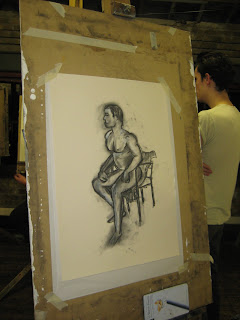

Ok, admittedly my first time was rather daunting. I did a couple of life drawing sessions during my foundation year and did around 4 this year at my local art gallery back in Wales but I find it such a challenge and struggle quite a bit. I'm more comfortable with simple fine liner line drawings and so expressive charcoal marks do not come naturally! The tutor gave me some handy advice- "Draw from the inside!" In other words, instead of drawing the image by outlining it, build it up using different patches of tonal shade. I can definitely see the advantage of this. instead of obsessing over shape, you instead gradually build up a recognizable form. Here's my attempt. More practice needed I think!
Saturday 30 October 2010
Trash Fashion Exhibition at the Science Museum
Despite being hidden in a corner at the back of the ground floor of the science museum, this small exhibition is extremely innovative, exciting and well worth a visit. To be honest, I wasn't terribly eager to visit the exhibition. 'Recycled', 'eco-friendly' fashion and textiles are referred to so commonly nowadays. Consumers who previously associated the term with the stereotypical image of a tree-hugging individual in a tofu kaftan are now encouraged to posses hundreds of jute bags, canvas bags, bags made out of crisp packets etc. Surely this is not achieving anything as far as the environment is concerned apart from satisfying our consciences in the belief that we are somehow 'helping'. But don't let this preconception put you off. This exhibition showcases high quality garments using groundbreaking technology. On the whole, they are garments you would look and admire without realizing that they are indeed eco-friendly.
.......................................................................................
I have chosen to examine 3 different examples of sustainable clothing, discussing their merits and failures and ultimately suggesting whether I could see a viable future for the project.
1. 'Bio Couture jacket'

In my opinion, the ‘BioCouture’ jacket stands out as one of the most radical projects. Made out of cellulose produced by millions of tiny bacteria grown in bathtubs of sweet green tea, this method of producing cellulose provides an ecologically refreshing alternative to cotton. The environmental advantages of this material are numerous. The designer Suzanne Lee is utilizing this ancient technique as a natural, non-toxic and compostable alternative to cotton which wastes billions of litres of water in its production each year. In addition, the fabric can also be dyed with natural colorants like turmeric, beetroot, blueberry and indigo.
Despite its advantages, 'BioCouture' has yet to gain widespread acceptance within the fashion community and many believe it lacks credibility or are simply put off by the unappealing use of bacteria. The first part of the process which involves growing the cellulose takes at least 2 weeks so one has to consider it as highly time consuming. The fact that Suzanne Lee herself has only made 10 garments in the past 7 years may well be a clear indication of this. However Suzanne Lee argues that the one month complete process is much shorter than the growth and harvesting time needed for cotton crops.
Practical disadvantages include the fabrics absorbing properties. If rain were to fall on your new 'BioCouture' jacket then the whole garment would turn to jelly and break down. Furthermore the materials' lack of stretch could hinder the wearer's comfort significantly.
So does this material have a realistic future within our fashion industry?
Scientists are working at solving some of the problems currently encountered. They are experimenting with the inclusion of water repelling molecules and how to manufacture the material on a large scale. Despite its significant environmentally friendly credentials, I believe that a lot of work in improving its appearance, feel and comfort will be needed to convert our cotton loving nation.
.......................................................................................
2. Kate Goldsworthy
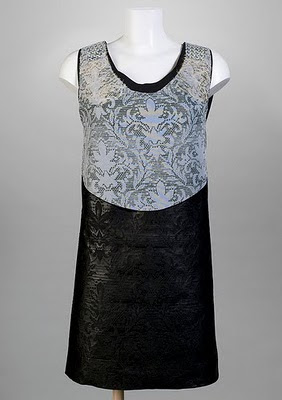
In contrast to the 'BioCouture' jacket the simple, eye catching design of this shift dress by Kate Goldsworthy would, in my opinion be a highly credible garment to find within our fashion industry. Goldsworthy has used a new laser technology called 'Clearweld' and has collaborated with Japanese textile company Teijin in formulating a chemical recycling process for polyester fiber.
ADVANTAGES
- The garments are created using only 100% polyester and therefore utilize material that would otherwise be destined for landfill. This would benefit the environment significantly as polyester takes a long period of time to decompose.
- As the material is 100% pure, at the end of its life it can be recycled again. This is often referred to as the 'Closed Loop Concept'. As well as being environmentally favorable, this continuous process can be economically beneficial as one could reduce costs if the garments are collected at the end of their life span.
- The process does not allow for any harmful chemical finishes and therefore has no negative secondary effects such as water contamination.
-As a fabric used for fashion and interiors, polyester has many advantageous qualities-
* Durable
* Does not stain easily
* Does not fray easily
* Holds shape and doesn't wrinkle
* Can be washed and dry-cleaned
* Cannot sustain a flame (i.e. will burn in isolated places but not catch on fire and spread)
* Mold, mildew, fungi etc. will not live on it
* Does not absorb moisture but allows for evaporation making it far cooler than cotton
DISADVANTAGES
- Currently, the laser technology means that there are many limitations as regards to the pattern designs one can create.
- The machinery costs are high. Not only is the initial purchase of lasers very expensive but sustaining the high energy costs could also pose significant problems.
- As discussed in the previous point, the high costs could push up prices and garments would cost a premium hence isolating the cheaper end of the market.
- The technology used is undeniably complex and trained technicians are required.
- If the process were to become economically viable the time taken to manufacture garments would need to be decreased significantly.
- Consideration must also be given to what would happen to all the other types of fabric in circulation if 100% polyester were to develop into a dominating fabric. These would surely all end up in landfill, contradicting the initial aim of the project.
-There has been discussion regarding the health effects of polyester. For example reports have shown that the electrostatic field it produces reduces the sperm count of humans.
-The practicality and constraints of the fabric must also be considered-
* It is made from oil which is ultimately a non-renewable material and is subject to price changes with the price of oil
* It lacks the natural feel of other fabrics such as cotton
* It will not absorb dyes
* Polyester can only be ironed at a very low temperature
So what does the future hold for this forward thinking project?
Goldsworthy discusses how "In future, large companies could operate local hubs where people bring their old clothes to be chemically recycled into fresh polyester fibres. New digital manufacturing methods would enable new clothes to be made individually and on demand at the same site, which would massively reduce material waste and transportation costs." I can definitely see the clear advantages of this material and production method however I am uncertain whether it is realistic to believe that the textile industry can be dominated by one fabric only.
.......................................................................................
3. Knit to Fit

Sandy Black's Knit to Fit initiative uses high tech technology to translate a 3D body scan into a seamless garment created by an automated knitting machine. This means that bespoke clothing could become an everyday reality which in turn would banish the tones of unsold clothing which ends up in landfill.
As with the other projects, Knit to Fit also holds a number of advantages and disadvantages.
ADVANTAGES
- No wasteful off-cuts
- Produces on-demand, customized clothes which in turn will reduce waste in the clothing supply chain
- The concept of 'bespoke' clothing will undoubtedly earn it credibility within the fashion industry
- Provides greater consumer comfort and satisfaction
DISADVANTAGES
- Does not provide a solution as regards to what to do with the abundance of garments already in circulation
- It is currently an extremely long process
- Once again, like the laser technology, costs are high. The machinery is expensive as well as the energy needed to power the complex body scanners. This could hinder its success significantly
- Do the body scans pose a health risk especially with repeated exposure?
The future for this project appears to be full of optimism and further development. Already, scientists in America have taken the concept a step further by experimenting with a system that allows an individual to try on clothes 'virtually' in order to cut down on unwanted online purchases. The bespoke nature of this project particularly appeals to me. I am definitely a fan of buying one well-made expensive garment which will last rather than several cheaper ones for the same price. However 'bespoke' clothing is more often than not far too expensive for the average consumer. This technology would make individually tailored garments a reality for everyone and not only the wealthy, whilst also reducing harmful environmental impact. Although I do not believe it would not provide an answer to the ultimate goal of a 'sustainable' fashion industry, it is one step in the right direction.
Sunday 24 October 2010
Rough Guide Theory Task
My first uni project was to compile a visually interesting and informative Rough Guide to the Covent Garden, China Town and Soho part of London. It was actually a really good way for me to find my feet and familiarize myself with at least one part of the city!

Also I really enjoyed the challenge of looking at things in exceptionally detailed or unexpected ways. I wanted to find inconspicuous elements that would show the areas in an original and subtle yet insightful way. I particularly enjoyed alternative ways of mapping, looking at pattern and the simplicity of reflections within puddles. It is so strange how the simplest of concepts can sometimes be the most stunning.
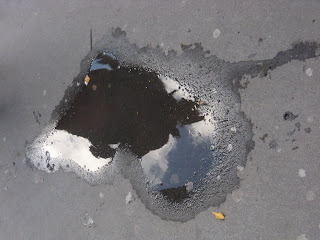
Alongside this visual mapping, we were asked to give our areas a context through some primary and secondary research.
COVENT GARDEN
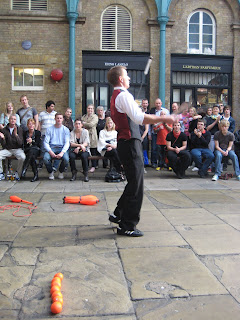
Covent Garden striked me as the complete package for a fun filled touristy day out. The atmosphere is that of one continuous bank holiday with people casually spilling out of the numerous bars, restaurants and cafes, killing endless hours smiling at the vaguely entertaining street performers and slipping from one to another expensive boutique. How civilized! It is somewhat hard to imagine that the area served as a practical fruit and veg market during much of its history. And yet more unexpected, served as a peaceful garden to an Abbey and Convent many years ago. Although during the 18th Century it gained the reputation of being a rather seedy, red-light district, in contrast, today it is arguably one of the most family orientated parts of London. The grand Royal Opera House sits proudly in the square and is personally one of the main reasons I would visit the area.
CHINA TOWN

Having an avid interest and infatuation with Asia, I personally love the bustle, disorganization and general rudeness that comes with visiting this area. Generally, I observed that people treated China Town like some sort of universal studios experience. They took endless photographs of themselves posed against anything vaguely oriental and either marveled at or pointed in disgust at the wealth of unusual Chinese goods and foodstuff. Interestingly enough, Chinatown was originally established in the east end but suffered a decline when partially destroyed during the London blitz. In the 1950s, British soldiers returning from the Far East and their new found appetites for Asian cuisine resulted in the flourish of Chinese restaurants within the Gerrard Street Area. I suppose one of the very few good things that came out of wartime horror was the introduction of new cultures which have indeed grown to a point that they are amalgamated into our British heritage. As a modern day area, one cannot deny the vibrant and exotic allure of visiting such an area, and no trip to London would be complete without some crispy peking duck and a fortune cookie!
SOHO
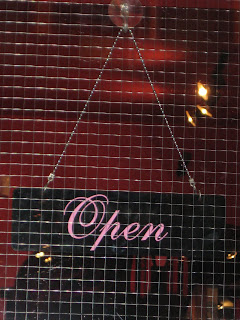
Bizarrely believed to be called Soho after a hunting cry, there's no doubting the seedy, sex-shop reputation of this area and it proudly does little to conceal this. It's 'entertainment' nightlife and film industry have dominated the area since the 20th Century, however since the 1980s it has transformed considerably by sprouting trendy media offices and a whole host of upmarket restaurants and cafes. I would note it as a definite celebrity 'hang out' and as a place to be seen rather than a place to see as is the case for Covent Garden and China Town.
After gaining a bit more knowledge about the area, the next step was to chose 3 objects from the area to reflect upon and compare.
1. A found object or an object from a market stall or second hand shop.
2. An object from a shop, department store or boutique.
3. An object from a museum or gallery.
OBJECT 1- Handkerchief

I decided to pop into WOW Retro Vintage shop on Mercer Street, Covent Garden and purchased a ladies flowered handkerchief for £2. The Chinese, fine art student behind the till was both uncommunicative and uninterested in my project. She said she worked there as she 'loved vintage'. A very 'a la mode' interest to have these days. The hanky caught my imagination because it is quite a personal belonging which can suggest a lot about its' owner, for example it's quality would traditionally reflect their social-economic class. It is also an item redundant in today's throwaway paper napkin society where it has become considered an old-fashioned, mumsy object. This saddened me and convinced me to give the hanky a new home!
It measures roughly 26cm by 26.5cm making it just off the size of a perfect square. It is made of a cotton which has softened considerably, suggesting it has been used and washed several times. A label indicates it has been made in England and that it is colour fast. The repeat pattern around the edges of the cloth features clusters of orange and blue flowers. Their simplicity and lack of detail makes their precise species hard to distinguish. The flower clusters are joined by stalks and leaves. In the background a simple square coil pattern begins by being defined and bold at the edges but becomes increasingly fragmented and faded towards the centre. The two dominant colours are a deep, warm orange and a sky blue, enhanced by a serpent greeny-turquoise for the leaves and pollen detail of each flower.
Keywords I associate with this object-
INTIMACY
PRACTICALITY
CHERISHED
PERSONAL
JOLLY
TRADITIONAL
HABITUAL
REUSABLE
WELL-WORN
HYGIENIC
DECORATIVE
OLD-FASHIONED
ABSORBENT
USEFUL
INSIGHTFUL
How would this object appear in another context?
Well, you would have little success at attempting to sell a brand-new fabric handkerchief let alone a second-hand one within a shop nowadays. Disposable culture has taken over leaving little place for the re-washable and re-usable handkerchief- perceived as a total time wasting idea. In the context of the vintage shop, the item made me think of the wearer, the memories and travels that the handkerchief and its owner had been on, the tears it had absorbed and the important part it had played in someones life. Place the same item within a shop and the words grubby, unhygienic and unwanted spring to mind. If one were to place the handkerchief within a museum however and label it as having a well-known or well regarded owner then I'm certain it would win the same appreciation as I encountered within the vintage shop. People would want to learn its story and realize its integral function within an individuals' daily life. It may even inspire some to ditch the paper and return to the fabric!
OBJECT 2 - Chinese preserved fruit
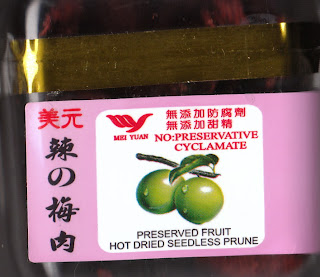
This box of preserved fruit (or to be more precise, hot dried seedless prunes) was purchased for £1.38 from Wonderful Patisserie Bakery on Gerrard Street, China Town. The grumpy cashier was suspiciously eying me up as I marveled at the somewhat regally boxed array of colourful dried fruits. She briskly informed me they were "Ready to eat" and "very tasty" before grabbing my money.
The fruit appear wrinkled, dry and rather tough. They have an unnatural burnt red colour due to the fake colouring and additives listed in the ingredients. They are presented within a hard, square plastic case. I think the lid gives it a grand, regal appearance suggesting it is a treasure box or protective casket. This lid is sealed by a piece of garish gold tape which certainly catches the eye. The bright pink label equally screamed out at me from the shelf and the clashing contrast with the unripe, green colour of the painted image of prunes further this. The colouring is garish and girly but nonetheless it certainly appealed to my eyes and I cannot wholly make up my mind whether the packaging is tacky or expensive looking.
Keywords I associate with this object-
EDIBLE
AUTHENTIC
CHEAP
TACKY
EXPENSIVE
CHEWY
DRY
TASTY
TRADITIONAL
SWEET
COMMON
FOREIGN
EXOTIC
UNUSUAL
Indeed it seems as though this object has evoked many contrasting words for me. You may wonder how an object can teeter between looking expensive or tacky but I believe that your opinion on the object may also depend on whether you are Asian or not. For example I remember going into an Asian grocery store in London with my Japanese friend a few weeks ago. I was in awe of a bottle of chilled green tea as it was covered in a beautiful intricate patterns bursting with colour. My friend was stunned at my amazement. She said that the brand was so common in Japan that when she saw the familiar bottle she thought of it as being cheap and tacky. It's so funny how I saw her cheap, common object as a treasured special artifact! So perhaps on a market stall in Beijing, this little box of dried fruit would be seen as a cheap, basic snack. However placed within the Food Hall of Selfridges would give the average person the impression that it was an exotic, foreign delicacy and hence we would not hesitate to spend money on buying a box. This demonstrates that our personal knowledge can influence the way we think, but we are also strongly influenced by the way things are presented to us within society. Even though this is often a fabricated impression by companies usually after our money, it is extremely difficult to avoid this influence.
OBJECT 3 - The Virgin of the Rocks by Leonardo da Vinci
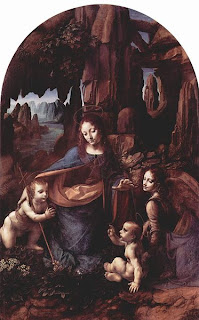
A dominating oil painting on wooden board painted 1495-1508 and measuring 189.5cm by 120cm. The painting is awe inspiring, inviting and exceptionally clear due to its recent 2 year restoration. I joined a guided tour of the National Gallery collection and was struck by the beauty of this particular painting. I think this was fueled further by the passionate talk given about this particular painting by the tour guide as it was one of her personal favourites. She guided us from the most minute detail, such as the pea-pod gold and red detailed embroidery to the unarguably stunning face of the angel, considered to be the most beautiful face of a woman ever seen. She also taught me a considerable amount- e.g. the image has 40 layers of glaze, da Vinci painted with his fingers, the masculine appearance of the hands is due to the fact that he painted using male models etc.
Keywords I associate with this object-
PASSION
FAMOUS
CELEBRATED
RECOGNIZED
RELIGIOUS
TREASURED
ADORED
PRICELESS
MIGHTY
UNPARALLELED
SKILLED
DETAILED
ALMIGHTY
Intrigued by my intense draw to the image, I decided to ask the gallery attendant a few questions to find out what were the reactions of others. Michael Hail said that many hundreds stop to look at the painting throughout the day. He personally was not a fan ("It just doesn't do much for me"), believing that the name da Vinci preceded the image. "People only come and see it because it's a da Vinci, but I personally rate his sketches far more", he said. Yes, this sounded criminal to my ears. This painting is truly amazing and the exquisite detail really does leave you breathless regardless of whether it was painted by da Vinci or a total amateur. I stood and observed the crowds of people for a while and noticed that although many did make a beeline for the image, few actually stood, gazed and soaked it up in its full glory. It's as if they were there to merely tick the box of having seen a da Vinci painting. This once again demonstrates the way society influences our appreciation of objects. Michael Hail of course, defiantly bucks this trend!
Also I really enjoyed the challenge of looking at things in exceptionally detailed or unexpected ways. I wanted to find inconspicuous elements that would show the areas in an original and subtle yet insightful way. I particularly enjoyed alternative ways of mapping, looking at pattern and the simplicity of reflections within puddles. It is so strange how the simplest of concepts can sometimes be the most stunning.
Alongside this visual mapping, we were asked to give our areas a context through some primary and secondary research.
COVENT GARDEN
Covent Garden striked me as the complete package for a fun filled touristy day out. The atmosphere is that of one continuous bank holiday with people casually spilling out of the numerous bars, restaurants and cafes, killing endless hours smiling at the vaguely entertaining street performers and slipping from one to another expensive boutique. How civilized! It is somewhat hard to imagine that the area served as a practical fruit and veg market during much of its history. And yet more unexpected, served as a peaceful garden to an Abbey and Convent many years ago. Although during the 18th Century it gained the reputation of being a rather seedy, red-light district, in contrast, today it is arguably one of the most family orientated parts of London. The grand Royal Opera House sits proudly in the square and is personally one of the main reasons I would visit the area.
CHINA TOWN
Having an avid interest and infatuation with Asia, I personally love the bustle, disorganization and general rudeness that comes with visiting this area. Generally, I observed that people treated China Town like some sort of universal studios experience. They took endless photographs of themselves posed against anything vaguely oriental and either marveled at or pointed in disgust at the wealth of unusual Chinese goods and foodstuff. Interestingly enough, Chinatown was originally established in the east end but suffered a decline when partially destroyed during the London blitz. In the 1950s, British soldiers returning from the Far East and their new found appetites for Asian cuisine resulted in the flourish of Chinese restaurants within the Gerrard Street Area. I suppose one of the very few good things that came out of wartime horror was the introduction of new cultures which have indeed grown to a point that they are amalgamated into our British heritage. As a modern day area, one cannot deny the vibrant and exotic allure of visiting such an area, and no trip to London would be complete without some crispy peking duck and a fortune cookie!
SOHO
Bizarrely believed to be called Soho after a hunting cry, there's no doubting the seedy, sex-shop reputation of this area and it proudly does little to conceal this. It's 'entertainment' nightlife and film industry have dominated the area since the 20th Century, however since the 1980s it has transformed considerably by sprouting trendy media offices and a whole host of upmarket restaurants and cafes. I would note it as a definite celebrity 'hang out' and as a place to be seen rather than a place to see as is the case for Covent Garden and China Town.
After gaining a bit more knowledge about the area, the next step was to chose 3 objects from the area to reflect upon and compare.
1. A found object or an object from a market stall or second hand shop.
2. An object from a shop, department store or boutique.
3. An object from a museum or gallery.
OBJECT 1- Handkerchief

I decided to pop into WOW Retro Vintage shop on Mercer Street, Covent Garden and purchased a ladies flowered handkerchief for £2. The Chinese, fine art student behind the till was both uncommunicative and uninterested in my project. She said she worked there as she 'loved vintage'. A very 'a la mode' interest to have these days. The hanky caught my imagination because it is quite a personal belonging which can suggest a lot about its' owner, for example it's quality would traditionally reflect their social-economic class. It is also an item redundant in today's throwaway paper napkin society where it has become considered an old-fashioned, mumsy object. This saddened me and convinced me to give the hanky a new home!
It measures roughly 26cm by 26.5cm making it just off the size of a perfect square. It is made of a cotton which has softened considerably, suggesting it has been used and washed several times. A label indicates it has been made in England and that it is colour fast. The repeat pattern around the edges of the cloth features clusters of orange and blue flowers. Their simplicity and lack of detail makes their precise species hard to distinguish. The flower clusters are joined by stalks and leaves. In the background a simple square coil pattern begins by being defined and bold at the edges but becomes increasingly fragmented and faded towards the centre. The two dominant colours are a deep, warm orange and a sky blue, enhanced by a serpent greeny-turquoise for the leaves and pollen detail of each flower.
Keywords I associate with this object-
INTIMACY
PRACTICALITY
CHERISHED
PERSONAL
JOLLY
TRADITIONAL
HABITUAL
REUSABLE
WELL-WORN
HYGIENIC
DECORATIVE
OLD-FASHIONED
ABSORBENT
USEFUL
INSIGHTFUL
How would this object appear in another context?
Well, you would have little success at attempting to sell a brand-new fabric handkerchief let alone a second-hand one within a shop nowadays. Disposable culture has taken over leaving little place for the re-washable and re-usable handkerchief- perceived as a total time wasting idea. In the context of the vintage shop, the item made me think of the wearer, the memories and travels that the handkerchief and its owner had been on, the tears it had absorbed and the important part it had played in someones life. Place the same item within a shop and the words grubby, unhygienic and unwanted spring to mind. If one were to place the handkerchief within a museum however and label it as having a well-known or well regarded owner then I'm certain it would win the same appreciation as I encountered within the vintage shop. People would want to learn its story and realize its integral function within an individuals' daily life. It may even inspire some to ditch the paper and return to the fabric!
OBJECT 2 - Chinese preserved fruit

This box of preserved fruit (or to be more precise, hot dried seedless prunes) was purchased for £1.38 from Wonderful Patisserie Bakery on Gerrard Street, China Town. The grumpy cashier was suspiciously eying me up as I marveled at the somewhat regally boxed array of colourful dried fruits. She briskly informed me they were "Ready to eat" and "very tasty" before grabbing my money.
The fruit appear wrinkled, dry and rather tough. They have an unnatural burnt red colour due to the fake colouring and additives listed in the ingredients. They are presented within a hard, square plastic case. I think the lid gives it a grand, regal appearance suggesting it is a treasure box or protective casket. This lid is sealed by a piece of garish gold tape which certainly catches the eye. The bright pink label equally screamed out at me from the shelf and the clashing contrast with the unripe, green colour of the painted image of prunes further this. The colouring is garish and girly but nonetheless it certainly appealed to my eyes and I cannot wholly make up my mind whether the packaging is tacky or expensive looking.
Keywords I associate with this object-
EDIBLE
AUTHENTIC
CHEAP
TACKY
EXPENSIVE
CHEWY
DRY
TASTY
TRADITIONAL
SWEET
COMMON
FOREIGN
EXOTIC
UNUSUAL
Indeed it seems as though this object has evoked many contrasting words for me. You may wonder how an object can teeter between looking expensive or tacky but I believe that your opinion on the object may also depend on whether you are Asian or not. For example I remember going into an Asian grocery store in London with my Japanese friend a few weeks ago. I was in awe of a bottle of chilled green tea as it was covered in a beautiful intricate patterns bursting with colour. My friend was stunned at my amazement. She said that the brand was so common in Japan that when she saw the familiar bottle she thought of it as being cheap and tacky. It's so funny how I saw her cheap, common object as a treasured special artifact! So perhaps on a market stall in Beijing, this little box of dried fruit would be seen as a cheap, basic snack. However placed within the Food Hall of Selfridges would give the average person the impression that it was an exotic, foreign delicacy and hence we would not hesitate to spend money on buying a box. This demonstrates that our personal knowledge can influence the way we think, but we are also strongly influenced by the way things are presented to us within society. Even though this is often a fabricated impression by companies usually after our money, it is extremely difficult to avoid this influence.
OBJECT 3 - The Virgin of the Rocks by Leonardo da Vinci
A dominating oil painting on wooden board painted 1495-1508 and measuring 189.5cm by 120cm. The painting is awe inspiring, inviting and exceptionally clear due to its recent 2 year restoration. I joined a guided tour of the National Gallery collection and was struck by the beauty of this particular painting. I think this was fueled further by the passionate talk given about this particular painting by the tour guide as it was one of her personal favourites. She guided us from the most minute detail, such as the pea-pod gold and red detailed embroidery to the unarguably stunning face of the angel, considered to be the most beautiful face of a woman ever seen. She also taught me a considerable amount- e.g. the image has 40 layers of glaze, da Vinci painted with his fingers, the masculine appearance of the hands is due to the fact that he painted using male models etc.
Keywords I associate with this object-
PASSION
FAMOUS
CELEBRATED
RECOGNIZED
RELIGIOUS
TREASURED
ADORED
PRICELESS
MIGHTY
UNPARALLELED
SKILLED
DETAILED
ALMIGHTY
Intrigued by my intense draw to the image, I decided to ask the gallery attendant a few questions to find out what were the reactions of others. Michael Hail said that many hundreds stop to look at the painting throughout the day. He personally was not a fan ("It just doesn't do much for me"), believing that the name da Vinci preceded the image. "People only come and see it because it's a da Vinci, but I personally rate his sketches far more", he said. Yes, this sounded criminal to my ears. This painting is truly amazing and the exquisite detail really does leave you breathless regardless of whether it was painted by da Vinci or a total amateur. I stood and observed the crowds of people for a while and noticed that although many did make a beeline for the image, few actually stood, gazed and soaked it up in its full glory. It's as if they were there to merely tick the box of having seen a da Vinci painting. This once again demonstrates the way society influences our appreciation of objects. Michael Hail of course, defiantly bucks this trend!
Subscribe to:
Posts (Atom)
